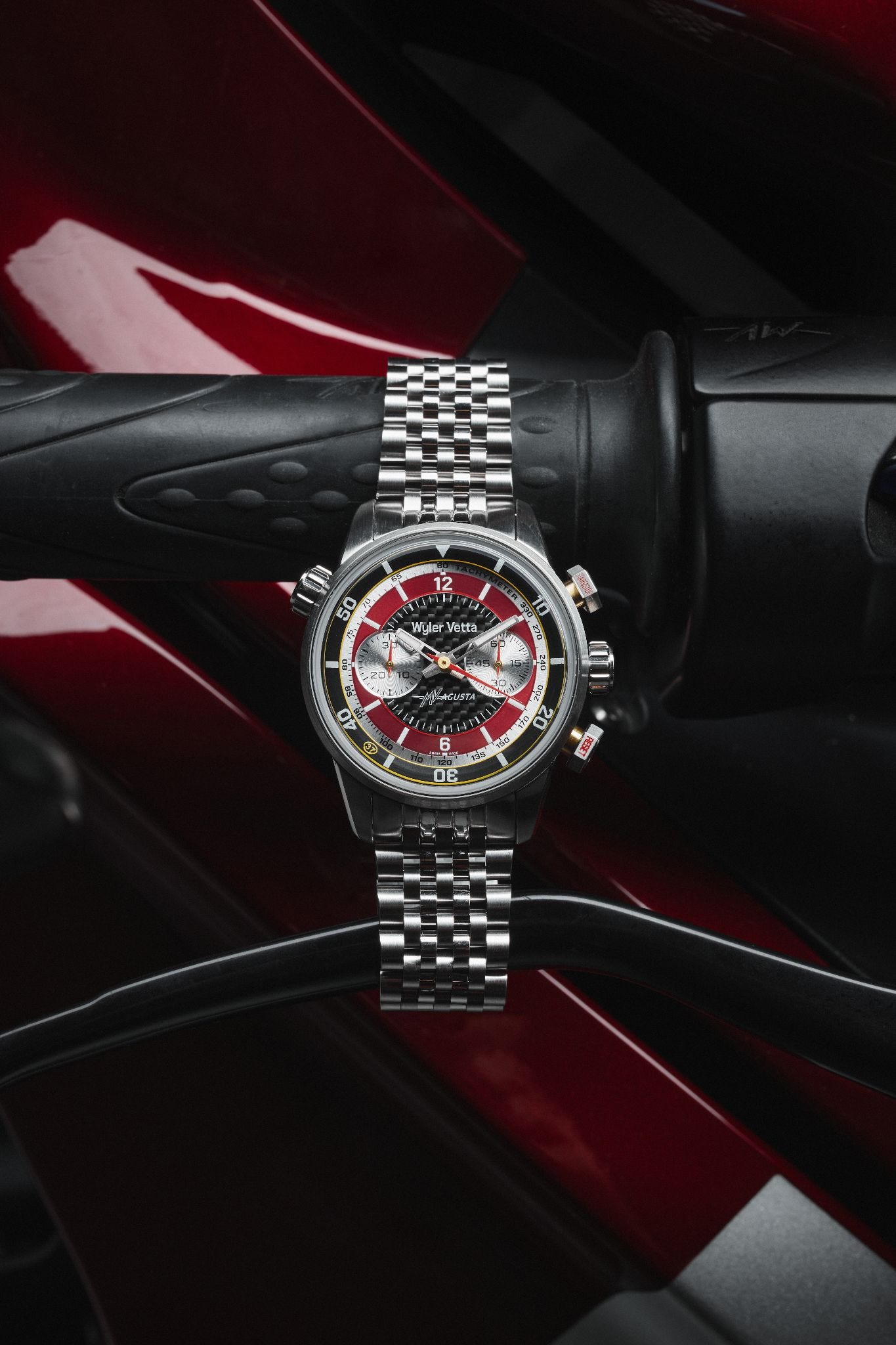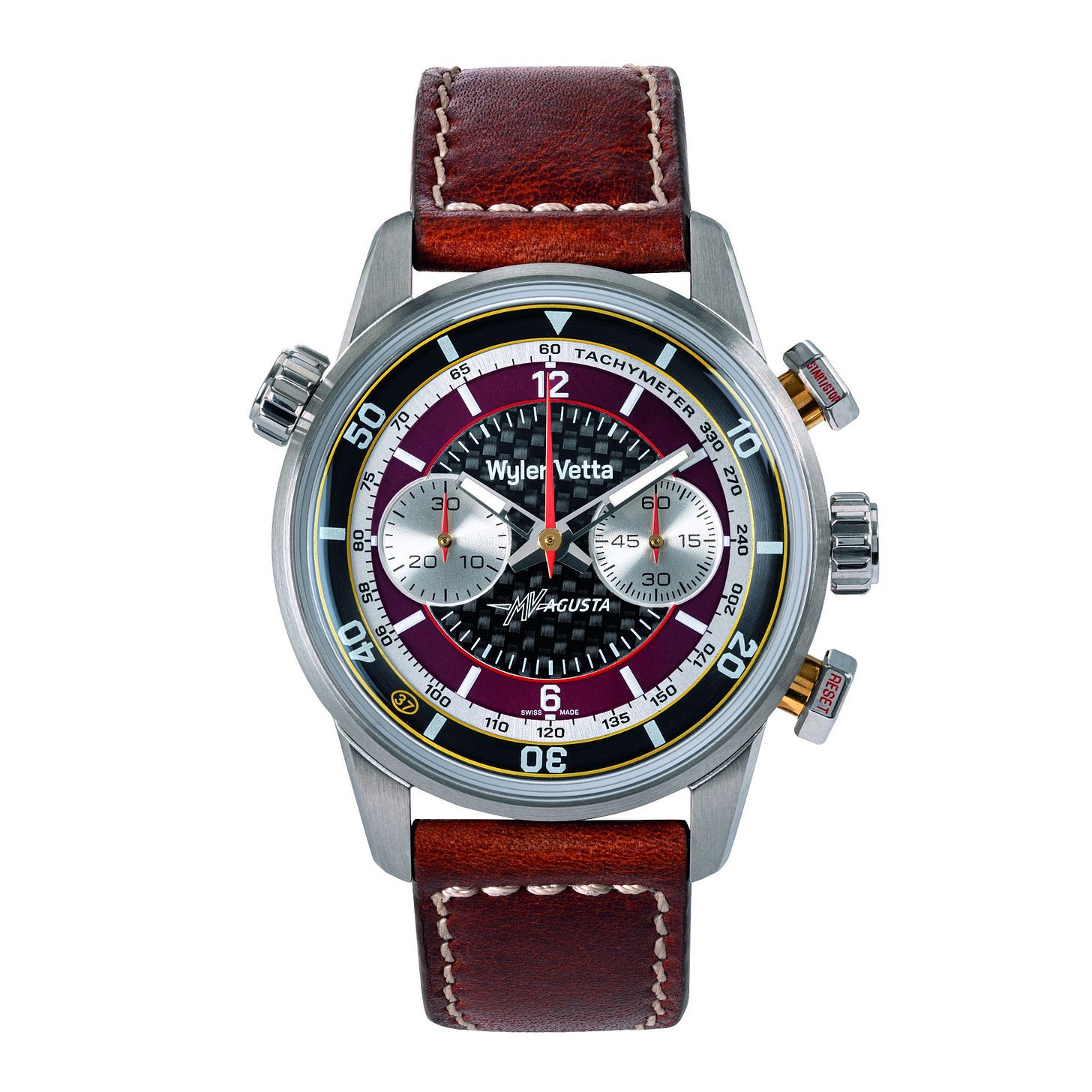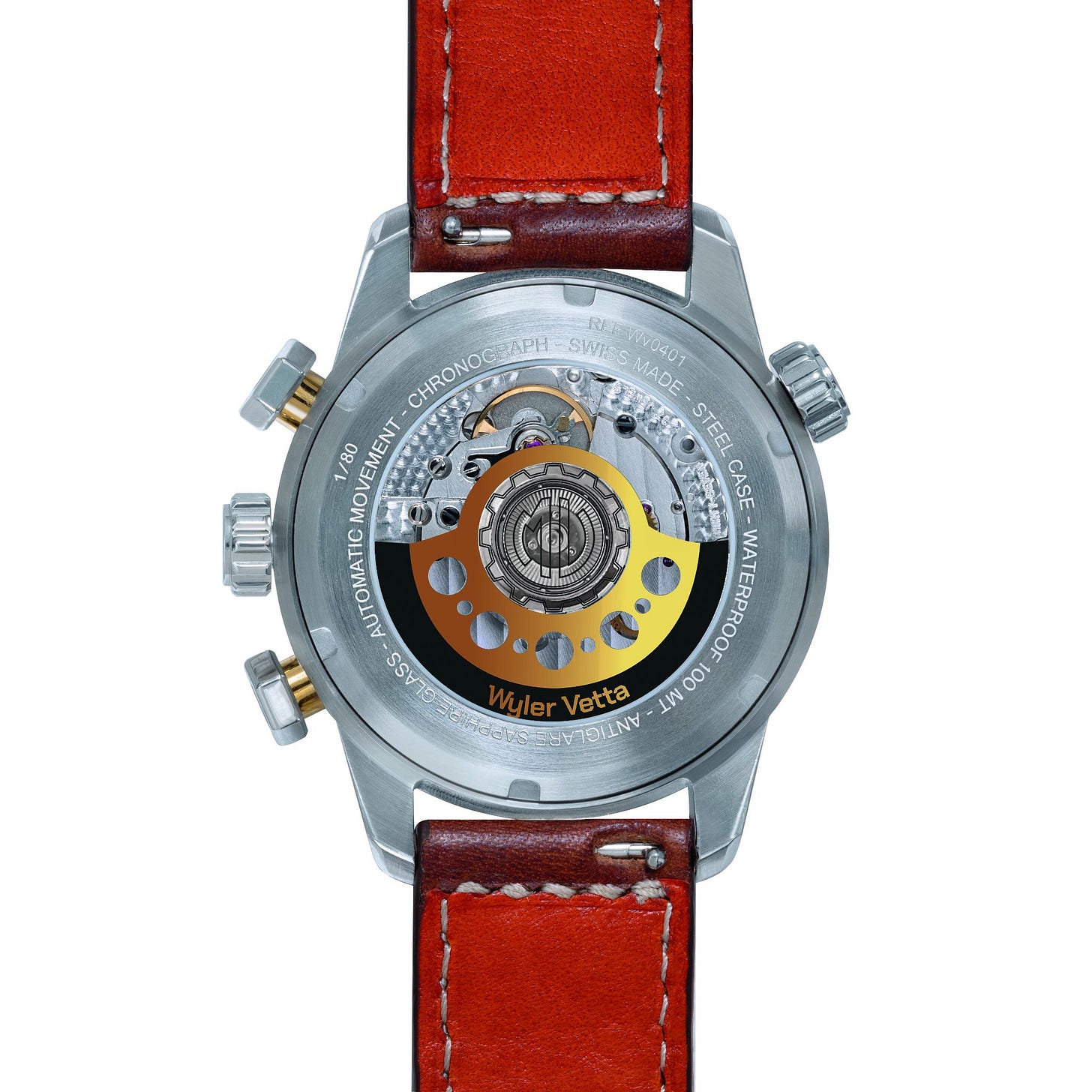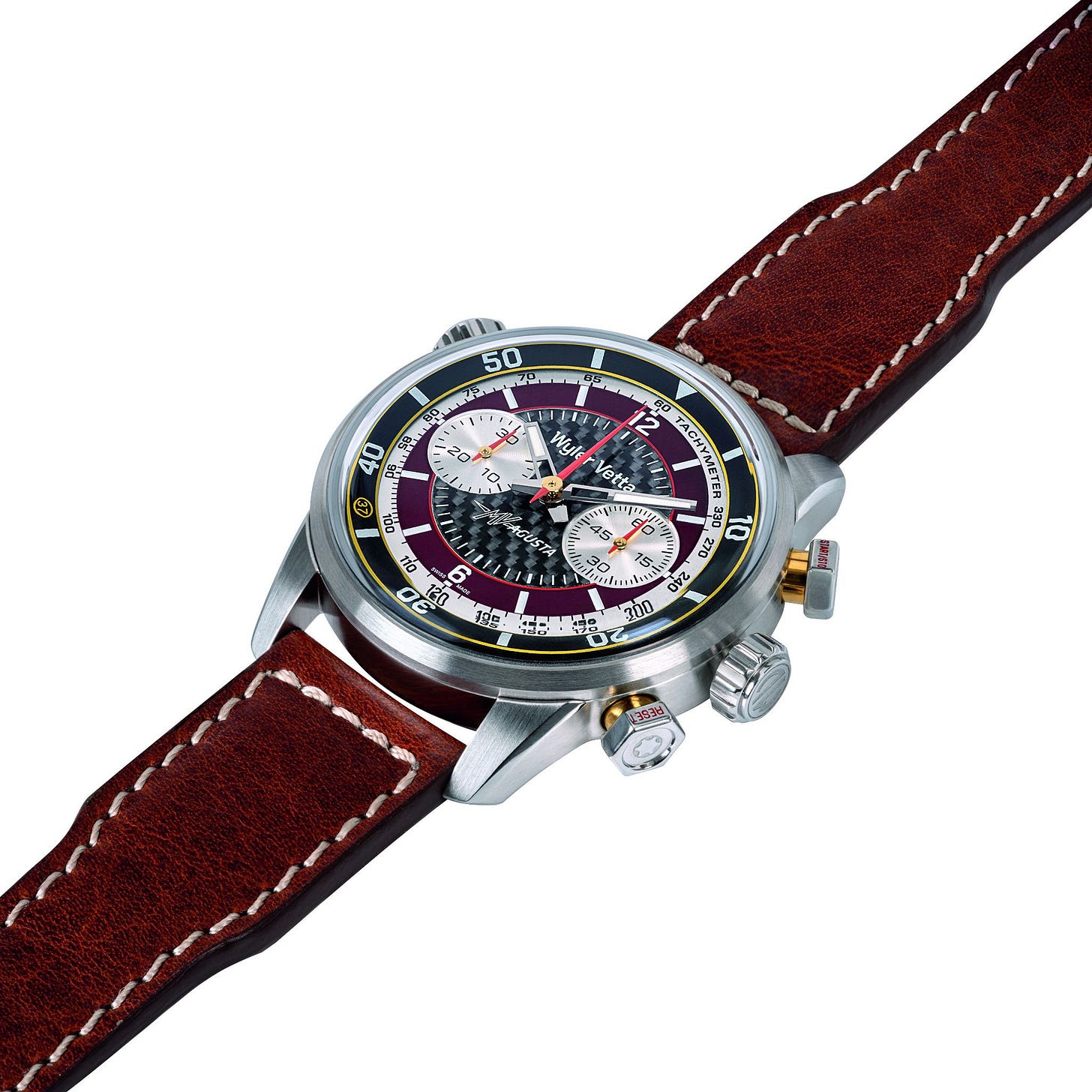Italian Passion Contained in Swiss Precision
Where Swiss discipline meets Italian speed — a chronograph that promises velocity, not movement, and seduces through the illusion of motion contained within stillness.
The Contradiction
A timepiece that promises speed without moving an inch, whispers of victories never personally witnessed, and seduces with the allure of Italian racing heritage while remaining firmly Swiss at heart.
In the realm of mechanical objects, few possess such contrasting identities as the Cronografo Wyler Vetta × MV Agusta. The collision of Swiss watchmaking discipline with Italian motorcycle exuberance creates a peculiar tension—like finding a meticulously pressed suit in a garage filled with the intoxicating scent of motor oil. This 40mm chronograph does not merely tell time; it attempts to bottle the essence of velocity and wrap it around your wrist, promising to transform mundane Tuesday mornings into Motomondiale moments, all while never exceeding 10 ATM of water resistance.
The Collaboration
To understand this seductive collaboration, we must position it within today’s luxury landscape where heritage brands perpetually seek cross-pollination. Wyler Vetta—a historic Swiss watchmaker with Italian roots dating to 1924—occupies an intriguing middle space in horology’s hierarchy. Neither mainstream luxury conglomerate nor cutting-edge independent, it trades on a storied past that includes dropping watches from the Eiffel Tower and adorning the wrists of Albert Einstein and Marcello Mastroianni.
MV Agusta, meanwhile, stands as Italian motorcycle aristocracy, with a racing pedigree that includes 37 world championships and a reputation for producing motorcycles that blend engineering excellence with sculptural beauty. Both brands exist in the shadow of larger competitors, making this alliance one of mutual reinforcement against market giants.
The Marketing Claim
The press materials speak of “shared values” and “maniacal attention to mechanics,” suggesting an inevitable marriage of kindred spirits. The reality, as always, is more pragmatic. Both brands leverage each other’s cultural cache in a market where authentic heritage is perhaps the most valuable currency.
The carbon fiber dial center and Rosso Verghera background are direct citations from motorcycle design, creating a tangible connection that obscures the fact that the ETA 2894 movement inside the chronograph is widely available across dozens of brands. The collaboration’s strength lies not in manufacturing exclusivity but in aesthetic conversation.
The Mechanical Ritual
Yet there remains something genuinely alluring about this timepiece that transcends marketing convenience. The chronograph’s pushers, inspired by the Torx screws on MV Agusta fuel caps, offer a tactile pleasure unique to mechanical interfaces.
The resistance as you depress the button, followed by the crisp snap of the chronograph hand jumping to attention, creates a micro-moment of mechanical satisfaction. The rotating rehaut, controlled by the crown at 10 o’clock, performs a similar mechanical ballet. These interactions form a vocabulary of touch that connects wearer to object in ways purely digital interfaces cannot—a physical engagement that mirrors the visceral experience of motorcycle riding translated into wrist-sized proportions.
The Human Reality
The marketing narrative suggests the chronograph is built for those living life at racing speeds, yet the human reality is that most purchasers will never exceed 130 km/h, and their most daring maneuver will be navigating an espresso and brioche while checking the time.
The watch’s 80-piece limited edition status reflects not production constraints but the artificial scarcity that fuels desire. Similarly, the “37” inscription between 7 and 8 o’clock celebrates MV Agusta’s world championships—victories most wearers have never witnessed yet are invited to claim through ownership.
What the watch actually offers is not speed but its suggestion—the comfort of knowing one could measure fractions of seconds, even when most moments blur together in day-to-day life.
The Craft Behind the Myth
Setting aside the romanticized histories both brands cultivate, the craftsmanship deserves genuine appreciation. The chronograph’s proportions (40mm diameter, 12.6mm thickness) show restraint in an era of downsizing watches.
The display caseback revealing the decorated movement with custom MV Agusta rotor demonstrates attention to detail, while the quick-release system for switching between the leather strap and steel bracelet reflects pragmatic consideration for the wearer—mirroring the motorcycle rider’s transformation from everyday citizen to weekend racer.
The Psychology of Precision
While technically functioning as a precision timing instrument, the watch’s psychological role is far more significant. The €3,900 price tag purchases membership in a narrative of speed, precision, and exclusivity.
The red seconds hand sweeping across the dial evokes the tachometer of a motorcycle—a visual connection to acceleration and the thrill of controlled power. Each glance at the wrist is not merely to check the hour but to reaffirm connection to a world of mechanical excellence and Italian racing heritage.
Therein lies the beautiful contradiction: the watch measures with precision what most owners will never need to calculate. The tachymeter scale can determine speed over distance, yet will likely never be used for its intended purpose. The carbon fiber dial—lightweight material crucial in racing motorcycles—saves imperceptible micrograms in a watch that will never need to reduce weight for performance.
This tension between technical capability and practical irrelevance does not diminish the watch; it enhances its appeal. Like the motorcycle capable of 280 km/h but constrained by speed limits, the chronograph’s excessive competence offers reassurance rather than utility—a promise of capability held in reserve.
The Honest Illusion
The Cronografo Wyler Vetta × MV Agusta succeeds not as a revolutionary timepiece but as an object of desire that connects seemingly disparate mechanical worlds. Its charm lies precisely in the space between what it promises and what it delivers—not disappointment but a delicious tension.
What I admire is not the technical innovation but the emotional intelligence behind the design choices. The watch understands that we do not wear chronographs to measure time but to feel connected to something larger than our daily routines.
In this sense, it is honest about its true purpose: to evoke rather than perform.
About the Author
Sergio Galanti is an independent writer and brand strategist exploring the intersections of luxury, culture, and time. As editor of WatchDossier, he examines watchmaking through the lenses of craft, history, and strategy.
Further Reading
Subscribe watchdossier.ch to receive more insights on luxury, craftsmanship, and collecting.







